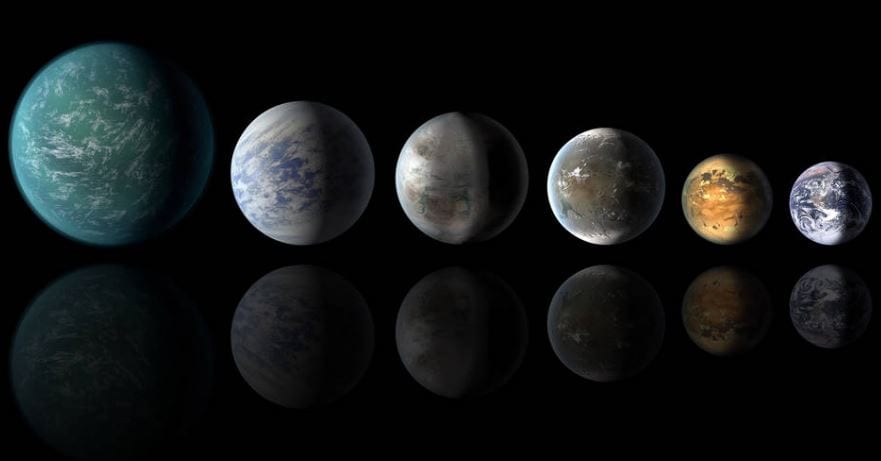With NASA making one announcement after another regarding its search for alien life, conspiracy theorists, UFO seekers and extraterrestrial enthusiasts across the world can hardly contain their excitement. Most of them are convinced that the US space agency is finally starting to confirm that intelligent life forms from elsewhere in the Universe have been visiting us.
NASA hinted last week during a news teleconference that it was about to announce to the world more details on the latest discoveries made by the Kepler Space Telescope.
Kepler, a space observatory, was launched by NASA on 7th March 2009, into an Earth-trailing heliocentric orbit – its aim is to discover Earth-sized planets orbiting other stars outside our Solar System. In other words, it is part of a quest to find alien life – life forms not from Earth.
 A US extraterrestrial survey from National Geographic Channel in 2012 found that over 80 million American adults, or 36%, believe that UFOs exist. A significant number are convinced that governments are involved in covering up information on alien activities. The three totals above do not equal 100 because some responses were not possible to categorize.
A US extraterrestrial survey from National Geographic Channel in 2012 found that over 80 million American adults, or 36%, believe that UFOs exist. A significant number are convinced that governments are involved in covering up information on alien activities. The three totals above do not equal 100 because some responses were not possible to categorize.
Virtually all conspiracy theorists and alien enthusiasts are convinced that NASA, other space agencies and governments across the globe have kept the lid on a giant secret regarding the existence of extraterrestrial life for decades.
‘The truth is out there!’
They have been claiming for years that ‘the truth is out there’ and that the evidence will become so overwhelming and compelling that the powers that be will have to come clean and tell us all the truth.
Last week, Dr. Ellen Stofan, who has been NASA’s Chief Scientist since August 2013, and is also principal advisor to NASA Administrator Charles Bolden, announced that strong indications of life beyond Earth would probably be obtained within the next ten years.
 Dr. Ellen Stofan believes that it won’t be long before we have proof of alien life forms in other worlds. (Image: nasa.gov)
Dr. Ellen Stofan believes that it won’t be long before we have proof of alien life forms in other worlds. (Image: nasa.gov)
Dr. Stofan said last week: “I think we’re going to have strong indications of life beyond Earth within a decade.”
“I think we’re going to have definitive evidence within 20 to 30 years. We’re on the verge of things that people have wondered about for millennia.”
“Within all of our lifetimes we’re going to understand that there is life on other bodies in the solar system. We’re going to understand the implications of that for life here on Earth.”
Many ways to interpret her words
The conspiracy-theory community interpreted her words as a coded warning that we are soon going to be told about the existence of ultra-smart extraterrestrial beings.
C Club, a conspiracy theory website, made the following comment regarding NASA’s recent announcements:
“We will learn that aside from extraterrestrial beings visiting our planet and many different ET races tinkering with our DNA over millenia, there are ancient humanoid races that are more than 10 million years old.”
Most level-headed scientists and educated lay people across the globe interpreted Dr. Stofan’s words rather differently, believing that she was about to announce the discovery of perhaps a new Earth-like planet orbiting a parent star, maybe located in its habitable zone, or an upgraded Kepler mission.
 Scientists are finding more and more Earth-like planets in other planetary systems. Kepler-452b, a newly-discovered exoplanet, comes the closest of any found so far to matching our Earth-sun system. This artist’s impression of a planetary lineup shows habitable-zone exoplanets that are similar to Earth: from left, Kepler-22b, Kepler-69c, the just announced Kepler-452b, Kepler-62f and Kepler-186f. Earth is on the far right. (Image: nasa.gov)
Scientists are finding more and more Earth-like planets in other planetary systems. Kepler-452b, a newly-discovered exoplanet, comes the closest of any found so far to matching our Earth-sun system. This artist’s impression of a planetary lineup shows habitable-zone exoplanets that are similar to Earth: from left, Kepler-22b, Kepler-69c, the just announced Kepler-452b, Kepler-62f and Kepler-186f. Earth is on the far right. (Image: nasa.gov)
Over the past twenty years, astronomers have made huge strides in discovering exoplanets – planets outside our Solar System. Since, 1996, over five thousand exoplanets have been detected.
The vast majority of these exoplanets have been ultra-close to their parent star, completing an orbit (or year) in just a few hours, days or weeks. However, a sizeable number have also been found about as far from their star as we are from the Sun, completing one full orbit in one Earth-year.
NASA’s Kepler Mission is also interested in worlds that orbit much further out, with orbits like Jupiter and Saturn, which are 5.2 AUs and 10.1 AUs from the Sun respectively. One AU equals one Earth-to-Sun distance.
 Eminent theoretical physicist, cosmologist and author, Professor Stephen Hawking, wonders whether we should be advertising our presence to aliens. They could be much smarter and more advanced than us – we would be at their mercy if they responded to our messages. (Image: hawking.org.uk)
Eminent theoretical physicist, cosmologist and author, Professor Stephen Hawking, wonders whether we should be advertising our presence to aliens. They could be much smarter and more advanced than us – we would be at their mercy if they responded to our messages. (Image: hawking.org.uk)
Kepler Mission scientists are also interested in free-floating exoplanets that do not appear to orbit a parent star. According to some studies, free-floating exoplanets could be more common than stars in the Milky Way (our galaxy).
“This week, NASA’s K2 mission, the repurposed mission of the Kepler space telescope, and other ground-based observatories have teamed up to kick-off a global experiment in exoplanet observation. Their mission: survey millions of stars toward the center of our Milky Way galaxy in search of distant stars’ planetary outposts and exoplanets wandering between the stars.”
“While today’s planet-hunting techniques have favored finding exoplanets near their sun, the outer regions of a planetary system have gone largely unexplored. In the exoplanet detection toolkit, scientists have a technique well suited to search these farthest outreaches and the space in between the stars. This technique is called gravitational microlensing.”
Video – Do aliens exist?
In this video, Dr. Seth Shostak, Senior Astronomer at SETI Research, talks about the likelihood of alien life existing out there.
